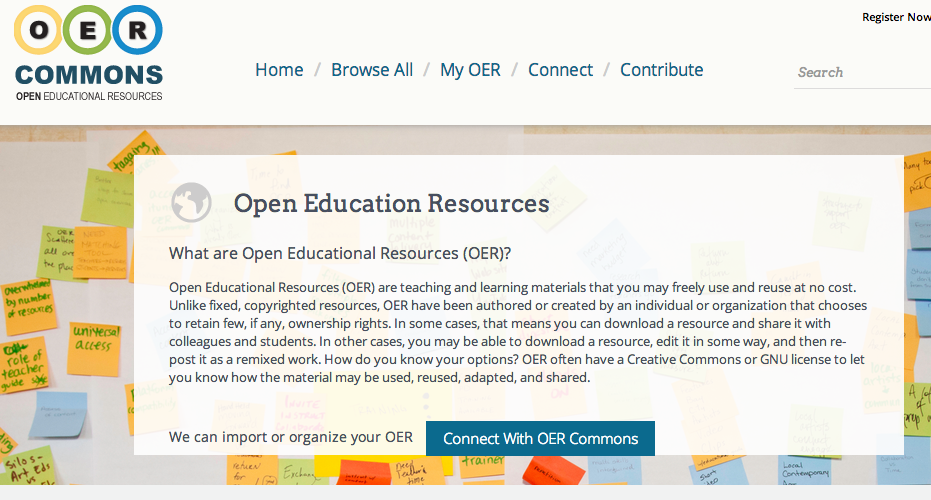
Creative Commons image sourced from Flickr via Xerte(c) Mo – 2013-03-03 08:45:42 www.flickr.com/35541543@N08/13505155565 (BY-NC-SA http://creativecommons.org/licenses/by-nc-sa/4.0/)
The development of educational resources is something that is often born out of the needs of students. Today, technology now pervades all aspects of our lives. However, increasingly we are a global community who are sharing data in unprecedented ways. This article aims to provide an introduction to Open Educational Resources, advice on their use and some insight into their place within the broader Greenwich Connect Project.
What are OER?
A definition from the William and Flora Hewlett Foundation states:
Whilst OER Commons say:

Open Education Resources definition from the OER Commons
Source: www.oercommons.org/products/oer – accessed 16/4/2014
[Creative Commons Attribution-NonCommercial-ShareAlike 3.0 License]
Examples of OER include individual documents, images, posters, homework assignments, quizzes, podcasts (audio/video), screencasts, games and lectures. But they also include collections of resources, full courses, MOOC’s (massive open online courses), course modules, syllabi and many more resources from digital archives across the world.
See the summary below, extracted from “Open & online: Wales, higher education and emerging modes of learning” (March 2014, Report of the Online Digital Learning Working Group).
Truly ‘open’ OERs meet the following criteria:
- freely available
- free of charge
- free to use
- free to re-use, adapt and distribute.
How did this begin?
In the 1970's, practices associated with the ‘openness’ movement were established norms within parts of the software development community. At this time, programmers shared and collaborated quite freely. Developing software and sharing their efforts openly, by keeping the ‘source code’ exposed for examination and further development by their peers (Graham, 2001). By the 1980’s, resistance from commercial enterprise meant that software distribution continued but often with restrictions on use. Proprietary software was released at the time, but often with restrictions. Even with systems such as “shareware” and “freeware”, these licenses permitted redistribution, but prevented access to source code. One of the first organisations to re-address these impositions was the Free Software Foundation (www.fsf.org), which was founded in 1985 by Dr. Richard Stallman. They established four essential freedoms for free software (See article – What is Free Software? https://gnu.org/philosophy/free-sw.html) and then developed the GNU/Linux operating system, based on these principles. In addition their work also produced a new form of license (General Public License) to legally protect the on-going usage, development, and distribution of free software (See – http://www.gnu.org/licenses/quick-guide-gplv3.html).
[youtube http://www.youtube.com/watch?v=POexV1k62_Y?rel=0&w=560&h=315]These efforts laid a foundation for others to follow, which meant that by 2002 Creative Commons Licenses were first made available. Individual copyright holders could now easily stipulate that their work could be copied and shared. It also broadened the scope to digital resources beyond software. Cable Green (Director of Global Learning from the Creative Commons) discusses the advantages gained by the proliferation of digital resources, within the legal framework provided by Creative Commons Licenses below.
[youtube http://www.youtube.com/watch?v=iQTOW8F9FWY?rel=0&start=460&end=684&autoplay=0&w=640&h=360]The impact of these free licenses mean that today sites holding digital resources such as YouTube, Vimeo, Flickr and Wikipedia have adopted Creative Commons Licenses into their work streams, massively impacting upon the number of publicly available resources (Reed, 2012). For more on Creative Commons Licenses, visit http://creativecommons.org/licenses/. We also have a page which looks at them here.
Practical Steps
A good place to start is to examine our own practise with the use of Open Educational Resources. A tool produced by JISC can help to review your level of adoption and use.
“How Open are you?” (JISC) – a wizard (series of questions with automated responses) which helps project managers/resource producers to self-access their use of Open Educational Resources within their organisation.
Finding resources is becoming increasingly easy, but filtering through to find exactly what you want can be a little harder. Both Google and YouTube now include tools to allow you to search for open licensed images and videos respectively. At the end of this article, there are also listed a variety of other places to find Open Educational Resources.
For further reading, please visit the UK OER guides and toolkits page here – https://openeducationalresources.pbworks.com/w/page/62662459/UKOER%20guides%20and%20toolkits
Conclusion
In order to best meet the aims of the Greenwich Connect Project, knowledge of how to find existing resources, leverage their use and ultimately contribute to the growing collection of resources are skills that are essential to have.
RT @philbarker: Q. How many OERs does it take change education? A. Only one, but education has to want to change @PeterBryantHE #ocwcglobal — Antony Coombs (@TELGreenwich) April 23, 2014
Ultimately the use and impact of Open Educational Resources will depend on how well they are supported and used. Together, we are able to achieve greater successes and with our continued combined efforts to review, re-mix, share and re-use we provide more opportunities to support our learning and teaching practises.
Handout
Open Educational Resources at the University of Greenwich – a summary handout resource for download is available here:- Open Educational Resources at the University of Greenwich v.1.1.
Example Open Educational Resource Sources
Xpert (www.nottingham.ac.uk/xpert) A JISC funded project aiming to progress the vision of a distributed architecture of e-learning resources for sharing and re-use.
Wikipedia (www.wikipedia.org) A web-based, free-content encyclopedia project supported by the Wikimedia Foundation and based on an openly editable model.
Jorum (www.jorum.ac.uk) A JISC funded service, which provides a repository of learning and teaching materials.
Khan Academy (www.khanacademy.org) A not-for-profit organisation providing free online courses/materials/resources. Founded on elementary mathematics and has since expanded to a wide variety of subjects and levels.
Sources:
S Graham, 2001 :- From Research Software to Open Source, Infomatics, Lecture Notes in Computer Science (Volume 2000, 2001, pp 195-208)
P Reed, 2012 :- Awareness, attitudes and participation of teaching staff towards the open content movement in one university (Research in Learning Technology, Vol. 20)
M Ripeanu, 2001 :- Peer-to-Peer Architecture Case Study: Gnutella Network (http://cs-www.cs.yale.edu/homes/arvind/cs425/doc/gnutella-rc.pdf)
GNU General Public License (GPL) – “A quick guide to the GNU GPL v3” http://www.gnu.org/licenses/quick-guide-gplv3.html
Pingback: Digital Identity | Greenwich ConnectGreenwich Connect